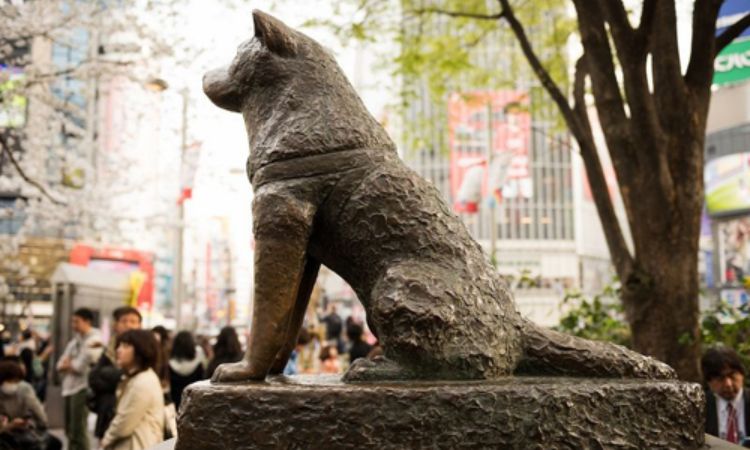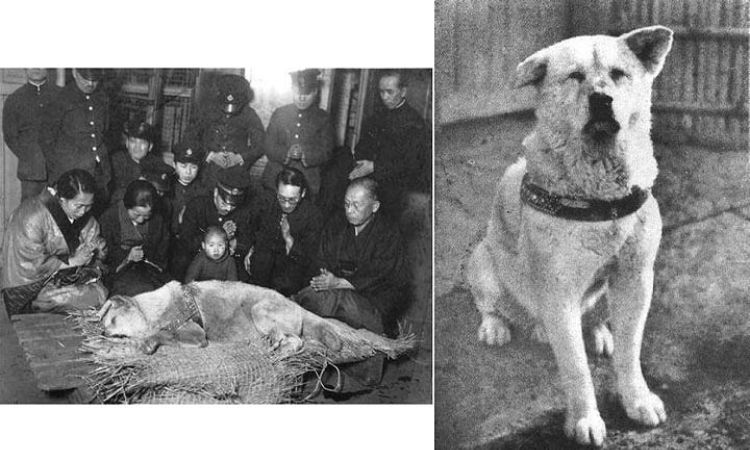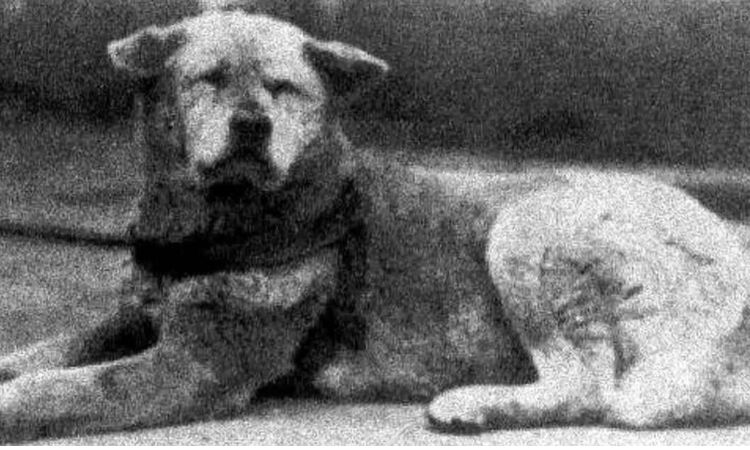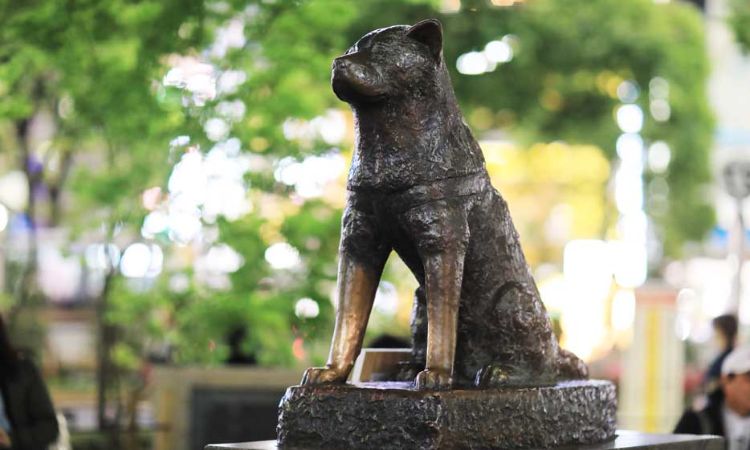Some stories quietly carve their place in history not through spectacle, but through unwavering love and devotion. One of the most poignant belongs to Hachikō, an Akita dog whose daily vigil at Tokyo’s Shibuya Station became a powerful symbol of loyalty. Long after his owner’s sudden death, Hachikō kept returning to the same spot, waiting faithfully for nearly a decade.
His quiet routine touched the hearts of passersby and grew into a legend that continues to inspire today. In this article, Nexus-pets explores the extraordinary legacy of Hachikō a story that proves a dog’s loyalty can outlast even time itself.

Background of Hachiko
Hachikō was an Akita Inu, a well-known Japanese dog breed famous for its loyalty and strong character. He was born on November 10, 1923, on a farm near Ōdate, a city in Akita Prefecture in northern Japan.
The Akita breed has a rich history and special cultural importance in Japan. It is officially recognized as a “natural monument” by the Japanese government. Akitas originated in the 1600s when local dogs were bred with Matagi hunting dogs to create strong, brave animals that could hunt and guard.
Akitas are not only admired for their physical strength but also for their deep loyalty and affection toward their owners. Hachikō’s story beautifully reflects these traits and helped make the Akita a national symbol of loyalty and devotion.
The Relationship Between Hachiko and Professor Ueno
Hidesaburō Ueno was a respected professor in the Department of Agriculture at Tokyo Imperial University, now known as the University of Tokyo. A dedicated academic with a deep appreciation for the Japanese Akita breed, Professor Ueno long desired to have a purebred Akita dog as a companion.
In early 1924, Ueno’s wish came true when one of his students, who was working in Akita Prefecture, found a young Akita puppy for him. This puppy was Hachikō, born on November 10, 1923, on a farm near Ōdate in Akita Prefecture. After a long 20-hour train journey, the fragile puppy arrived in Tokyo and was welcomed into Professor Ueno’s home in the Shibuya district.
Professor Ueno and Hachikō quickly formed a deep bond. Ueno, who had no children, treated Hachikō with great affection, allowing the puppy to sleep indoors, often under his bed, and sharing his daily life with him. Every morning, the professor would leave the house to catch the train to work, and Hachikō would accompany him part of the way to Shibuya Station. In the evenings, Hachikō would faithfully wait at the station to greet his owner’s return from work.
This daily routine became well known to local commuters and station staff, who admired the close friendship between the man and his dog. For years, Hachikō’s unwavering loyalty and devotion to Professor Ueno exemplified the unique and profound relationship they shared.

The Tragic Turning Point
In the spring of 1925, tragedy struck when Professor Hidesaburō Ueno suddenly passed away at the age of 53. While delivering a lecture at the University of Tokyo, he suffered a fatal cerebral hemorrhage. This unexpected loss left his beloved Akita dog, Hachiko, without his devoted owner.
Unaware of Ueno’s death, Hachiko continued his loyal routine each day. Every afternoon, he would faithfully appear at Shibuya Station at the exact time when his master’s train was due to arrive, patiently waiting for Ueno’s return. This daily vigil went on for nearly a decade—an extraordinary testament to unwavering loyalty and devotion.
Despite the passing of time and the absence of his master, Hachiko’s steadfast wait at the station became a poignant symbol throughout Japan. His story touched the hearts of many, transforming a simple dog’s loyalty into a lasting cultural icon of faithfulness and love.
Hachiko’s Growing Fame and Symbolism
At first, Hachiko’s constant presence at Shibuya Station was met with indifference and even annoyance by station staff and some commuters. Many saw him as just another stray dog lingering around, and he was sometimes mistreated by passersby, children, and station workers alike.
However, everything changed in the early 1930s when Hachiko’s story caught the attention of the media. In 1932, a reporter for the prestigious Asahi Shimbun newspaper published an article about the faithful dog who had been waiting for his deceased owner every day for years. This coverage sparked nationwide interest and admiration for Hachiko’s unwavering loyalty.
Soon, Hachiko became more than just a local curiosity—he transformed into a beloved national symbol representing the virtues of loyalty, devotion, and steadfastness. His story was embraced by the Japanese people as a powerful example of faithful companionship and unconditional love.
Over time, Hachiko’s legacy extended beyond emotional inspiration; his story was widely used in schools to teach children important values such as loyalty, respect for family, and perseverance. Through education and popular culture, Hachiko’s image has endured as a timeless emblem of devotion in Japan and around the world.

Memorials and Legacy
Hachiko’s incredible loyalty has inspired many and left a lasting mark in both Japan and worldwide. Several memorials have been established to honor his memory and celebrate his story.
- Bronze Statue at Shibuya Station (1934): The first statue was created by sculptor Teru Andō and unveiled outside Shibuya Station in 1934. Hachiko himself attended the ceremony, making it a heartfelt tribute.
- Destruction and Replacement: Unfortunately, the original statue was melted down during World War II. In 1948, Takeshi Ando, the original artist’s son, crafted a new statue that still stands today at Shibuya, serving as a famous meeting spot for locals and tourists.
Beyond the statue, Hachiko’s physical remains have also been preserved:
- Preserved Remains: After Hachiko passed away in 1935, his body was taxidermied and is now exhibited at the National Museum of Nature and Science in Ueno, Tokyo. This allows visitors to see the real dog behind the legend.
The tribute extends to the infrastructure around Shibuya Station as well:
- Hachikō Exit at Shibuya Station: One of the station’s main exits is named “Hachikō-guchi” (Hachiko Exit), ensuring that the loyal dog’s story is remembered by everyone passing through.
Hachiko’s legacy also thrives globally thanks to various cultural works:
- Global Recognition: His story has been told worldwide through books, television, and movies. Notably, the 1987 Japanese film Hachiko Monogatari and the 2009 Hollywood movie Hachi: A Dog’s Tale starring Richard Gere have brought Hachiko’s tale of devotion to international audiences, inspiring many with his unwavering loyalty.

Cultural Impact and Lessons from Hachiko
Hachiko embodies the core values deeply cherished in Japanese culture: loyalty, faithfulness, obedience, and unconditional love. His unwavering dedication—waiting every day for nearly ten years after his master’s death—has made him a powerful symbol of devotion and commitment.
This story of steadfastness, known as chūken, resonates strongly in Japan’s social and moral framework, reflecting ideals that are highly respected throughout the country. Beyond Japan, Hachiko has become a universal icon representing unwavering devotion, inspiring people worldwide to appreciate loyalty beyond just human relationships.
Moreover, his story significantly boosted the global popularity and preservation efforts of the Akita dog breed, highlighting the noble traits associated with these dogs. Today, Hachiko’s legacy remains a timeless reminder of the deep importance of loyalty, love, and faithfulness.






